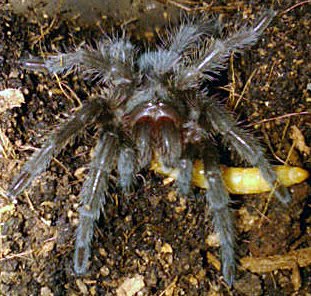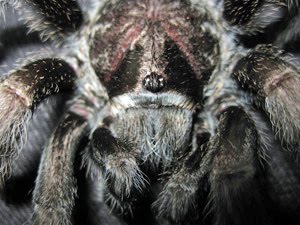The twenty will be raised in four groups of five each under varying temperature and feeding conditions in an effort to study the effects of temperature and food on growth rates. Group 1 will be fed 3 times weekly and kept at 80F, Group 2 will be fed 1 time weekly and kept at 80F, Group 3 will be fed 1 time weekly and kept at 70F, and Group 4 will be fed 3 times weekly and kept at 70F. All other conditions and environmental factors will be ketp the same for each group. I expect to have viable data within the next 3-5 years.
 |
| The Twenty |
 |
| One of The Twenty |
 |
| Adult Female, she is due for a molt |
 |
| Juvenile Female |
Onyx(009) the mature male I got from Joe (CAK on Arachnoboards) was sent out recently for a breeding loan. He was paired twice with the female and I told he made good insertions both times. Unfortunately, I was informed that she attacked him after the second pairing and he did not survive the night. I will miss him greatly, he was a beautiful specimen and quite large for a male of the species. Now I wait to see if the female will find conditions favorable to produce an egg sac next spring.
He was also paired with Sable(010) three times, all were very successful, and he was paired with Ebony(008), but she molted out. I was expecting to get him back so Icould air him with her again. I am now searching for another mature male to pair with Ebony(008)
Onyx my mature male G pulchra













































